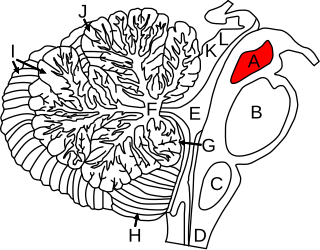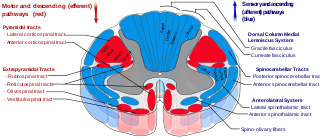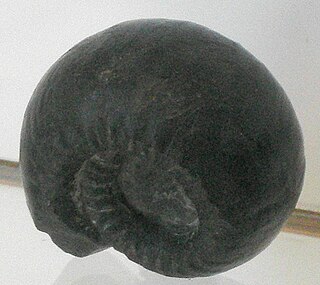
Redlichiida is an order of trilobites, a group of extinct marine arthropods. Species assigned to the order Redlichiida are among the first trilobites to appear in the fossil record, about halfway during the Lower Cambrian. Due to the difficulty to relate sediments in different areas, there remains some discussion, but among the earliest are Fallotaspis, and Lemdadella, both belonging to this order. The first representatives of the orders Corynexochida and Ptychopariida also appear very early on and may prove to be even earlier than any redlichiid species. In terms of anatomical comparison, the earliest redlichiid species are probably ancestral to all other trilobite orders and share many primitive characters. The last redlichiid trilobites died out before the end of the Middle Cambrian.

The parietal lobe is one of the four major lobes of the cerebral cortex in the brain of mammals. The parietal lobe is positioned above the temporal lobe and behind the frontal lobe and central sulcus.

The temporal lobe is one of the four major lobes of the cerebral cortex in the brain of mammals. The temporal lobe is located beneath the lateral fissure on both cerebral hemispheres of the mammalian brain.

The occipital lobe is one of the four major lobes of the cerebral cortex in the brain of mammals. The name derives from its position at the back of the head, from the Latin ob, "behind," and caput, "the head."

The midbrain or mesencephalon is the forward-most portion of the brainstem and is associated with vision, hearing, motor control, sleep and wakefulness, arousal (alertness), and temperature regulation. The name comes from the Greek mesos, "middle", and enkephalos, "brain".

The cerebrum, telencephalon or endbrain is the largest part of the brain containing the cerebral cortex, as well as several subcortical structures, including the hippocampus, basal ganglia, and olfactory bulb. In the human brain, the cerebrum is the uppermost region of the central nervous system. The cerebrum develops prenatally from the forebrain (prosencephalon). In mammals, the dorsal telencephalon, or pallium, develops into the cerebral cortex, and the ventral telencephalon, or subpallium, becomes the basal ganglia. The cerebrum is also divided into approximately symmetric left and right cerebral hemispheres.

The spinocerebellar tract is a nerve tract originating in the spinal cord and terminating in the same side (ipsilateral) of the cerebellum.

Brodmann area 31, also known as dorsal posterior cingulate area 31, is a subdivision of the cytoarchitecturally defined cingulate region of the cerebral cortex. In the human, it occupies portions of the posterior cingulate gyrus and medial aspect of the parietal lobe. Approximate boundaries are the cingulate sulcus dorsally and the parieto-occipital sulcus caudally. It partially surrounds the subparietal sulcus, the ventral continuation of the cingulate sulcus in the parietal lobe. Cytoarchitecturally it is bounded rostrally by the ventral anterior cingulate area 24, ventrally by the ventral posterior cingulate area 23, dorsally by the gigantopyramidal area 4 and preparietal area 5 and caudally by the superior parietal area 7 (H) (Brodmann-1909).
The perirhinal cortex is a cortical region in the medial temporal lobe that is made up of Brodmann areas 35 and 36. It receives highly processed sensory information from all sensory regions, and is generally accepted to be an important region for memory. It is bordered caudally by postrhinal cortex or parahippocampal cortex and ventrally and medially by entorhinal cortex.

The ventral ramus is the anterior division of a spinal nerve. The ventral rami supply the antero-lateral parts of the trunk and the limbs. They are mainly larger than the dorsal rami.
Pseudohaloritidae is the larger of two families that form the goniatitid superfamily Pseudohaloritoidea, the other being the monogenerc Maximitidae. They are part of the vast array of shelled cephalopods known as ammonoids that are more closely related to squids, belemnites, octopuses, and cuttlefish, than to the superficially similar Nautilus.

Gastrioceratoidea is one of 17 superfamilies in the suborder Goniatitina, ammonoid cephalopods from the Late Paleozoic.

Aturia is an extinct genus of Paleocene to Miocene nautilids within Aturiidae, a monotypic family, established by Campman in 1857 for Aturia Bronn, 1838, and is included in the superfamily Nautilaceae in Kümmel 1964.
Syringonautilidae is a family of Nautiloidea from the middle to late Triassic. Syringonautilidae comprise the last of the Trigonoceratoidea and are the source for the Nautilaceae which continued the Nautiloidea through the Mesozoic and into the Cenozoic right down to the recent. Syringonautilidae is a strictly Triassic family, derived early in the Triassic from the Grypoceratidae.

Grypoceratidae is the longest-lived family of the Trigonoceratoidea, or of the near equivalent Centroceratina; members of the Nautilida from the Upper Paleozoic and Triassic.
The Centroceratidae is the ancestral family of the Trigonoceratoidea and of the equivalent Centroceratina; extinct shelled cephalopods belonging to the order Nautilida
The painted swellshark is a little-known species of catshark, belonging to the family Scyliorhinidae, found in eastern Indonesia. This species reaches a maximum known length of 72 cm (28 in), and has a thick body with a short, broad and flattened head. It is dark gray with a variegated pattern of irregular darker and lighter blotches above, and lighter below with gray blotches and speckling on the snout. Like other swellsharks, it can inflate itself as a defensive measure.

Metacoceras is a nautilitoid cephalopod from the Upper Carboniferous (Pennsylvanian) and Permian, the shell of which is moderately evolute with a subquadrate whorl section, bearing nodes on the ventral or umbilical shoulders or both, but otherwise smooth. The siphuncle is small, subcentral and orthochoanitic. The suture has shallow ventral and lateral lobes but no dorsal or annular lobe.
Nannocetus is an extinct baleen whale belonging to the family Cetotheriidae.









